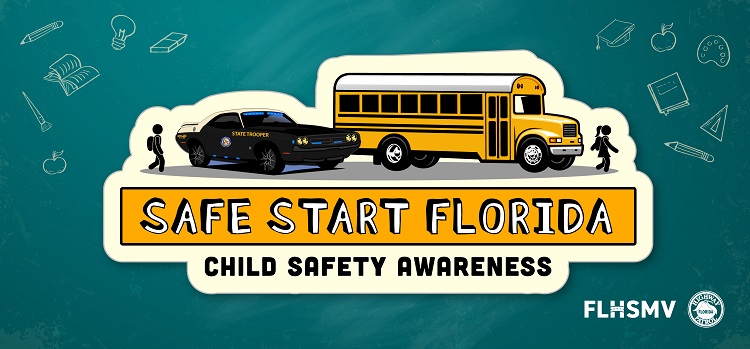Child Safety
Safety Belts and Child Restraints

For more resources, visit the main Child Safety web page.
Children should always be buckled up or in a proper child restraint, and everyone should be buckled up for safety. Read on to make sure you know the Florida safety belt law and important safety tips for children of all ages.
Safety Belts
- In the U.S., motor vehicle crashes are a leading cause of death among children. Proper child restraint and seat belt usage can drastically reduce the chances of death or serious injury if a crash occurs.
- In 2022, there were 85 child passenger fatalities due to vehicle crashes. Of these fatalities, almost 50 percent were not wearing any type of restraint.
- It’s important to remember that car seats aren’t just for babies. Florida law states that children ages 4 through 5 must be in a separate carrier, integrated child seat, or booster seat. There are many five-year-olds starting kindergarten this school year, and while they may not seem like your baby anymore or their peers may be in a different type of child restraint, it’s important for parents to use a car seat that fits their child’s current size and age.
- Florida law requires the use of seat belts or child restraint devices by drivers of motor vehicles, all front seat passengers, and all children riding in a vehicle under 18.
- Florida law requires children age 5 and under to be secured properly in a crash-tested, federally approved child restraint device.
- Children ages 0 to 3 must be in child restraint devices of a separate carrier or a vehicle manufacturer’s integrated child seat.
- Children age 4 through 5 must be in a separate carrier, integrated child seat or booster seat.
- The best seat is the one that fits your child’s size, is correctly installed, fits well in your car, and is used properly every time you drive.
- Be sure to read the seat’s instruction manual and the portion of your vehicle’s owner manual when installing a car seat in your vehicle.
- Remember to check for car seat and booster seat recalls and sign up to receive potential future alerts: https://www.nhtsa.gov/recalls
Types of Child Restraints:
- Seat Belt: A child should remain in a booster seat until he or she is big enough to fit in a seat belt properly. For a seat belt to fit properly, the lap belt must lie snugly across the upper thighs, not the stomach. The shoulder belt should lie snug across the shoulder and chest and not cross the neck or face.
- Booster Seat: In Florida, children ages 4 through 5 must be in a separate carrier, integrated child seat, or booster seat. Once a child outgrows a forward-facing car seat, children can travel in a booster seat, always in the back seat. If a vehicle does not have a backseat, the booster seat should be used with the air bag turned off.
- Forward-Facing Car Seat: A child should remain in a rear-facing car seat until he or she reaches the top height or weight limit allowed by the car seat’s manufacturer. Keep a child rear-facing as long as possible, usually until age 2 or 3. If the vehicle does not have a backseat, the forward-facing car seat should be used with the air bag turned off.
- Rear-Facing Car Seat: A rear-facing car seat is the best seat for a child under age 2 to use. Infant-only seats can only be used rear-facing. Convertible and 3-in-1 car seats typically have higher height and weight limits for the rear-facing position to keep a child rear-facing for a longer period of time. If the vehicle does not have a backseat, the rear-facing car seat should be used with the air bag turned off.
Resources
Florida Child Passenger Safety Seat Fitting Stations by County
Florida Statute on Child Restraint Requirements
National Highway Traffic Safety Administration – Parent Resources
How to Find the Right Car Seat

Dave Kerner, Executive Director